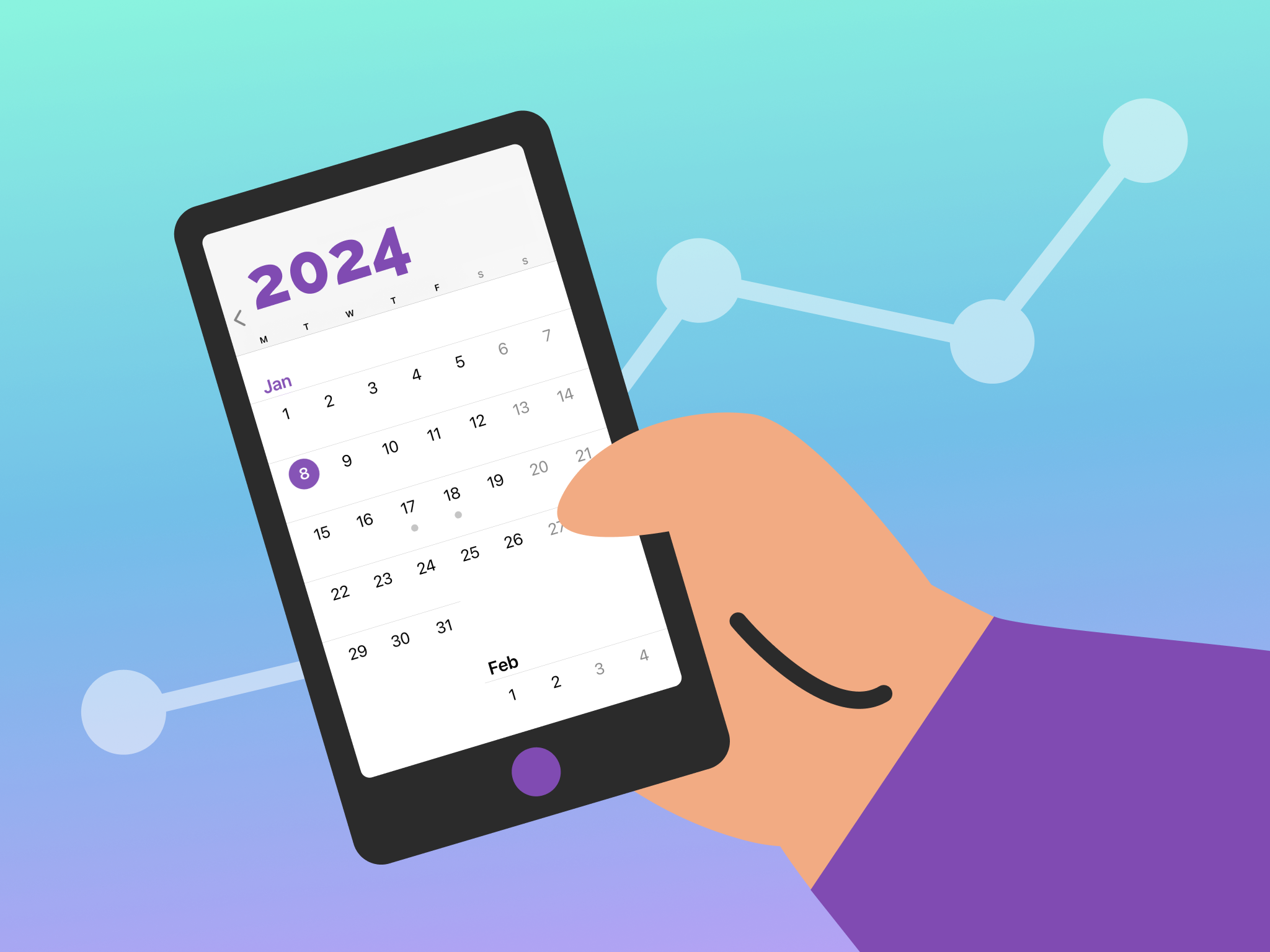2023 was a pivotal year in the world of digital advertising — AI dominated almost every conversation, and we saw the launch of the world’s first (but certainly not last) AI-generated ad for Gary’s and Bary’s peanut butter.
As the cookieless future became the cookieless present, advertisers, publishers, and adtech providers continued to refine and develop solutions and strategies for precision targeting that don’t intrude on user privacy.
As a result, contextual advertising had something of a renaissance, this time driven by AI capabilities that enable hyper-personalized ads without the use of third-party data.
As we look toward 2024, the year ahead will continue being shaped by AI, with McKinsey predicting that AI-driven productivity gains could add up to $4.4 trillion of value to the global economy.
Additionally, digital advertising will continue to go from strength to strength, with a predicted 5.7 percent growth in ad spend in 2024.
Marketers and advertisers who want to harness these developments need to stay ahead of the trends that will shape this year.
To help you, the Grapeseed team has rounded up our top seven programmatic advertising trends for 2024.
Read on as we unveil them.
1. Political Ad Spend Will Reach Record Highs
Political ad spend has been growing in recent years, and in the 2024 US presidential race, it will reach a new record high. An assessment by Group M anticipates that $15.9 billion will be spent on political ads this year — up 30 percent from the 2019-2020 election cycle.
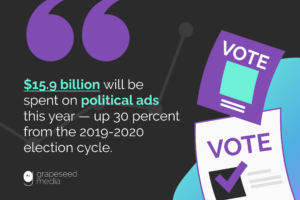
This will make US political advertising the tenth-largest singular ad market in the world — larger than the whole of Australia’s, according to The Guardian.
Although much of the political spend will go to television ads, Group M notes that a growing portion of the budget will go to digital ads, and predicts that AI will increasingly be used in ad placement.
Additionally, the UK is expected to go to the polls this year, with a general election anticipated in the second half of the year and no later than January 2025.
Like their counterparts across the pond, British political parties are expected to go all-in with their advertising — and it’s reported that the Conservative Party spent an unusually high figure on ads for Rishi Sunak in December 2023, according to political transparency group Who Targets Me.
Curious about what the most effective political advertising techniques will be in 2024? Check out this comprehensive guide.
2. Addressable TV Will Grow
In recent years, CTV advertising has been at the forefront of discussions as traditional TV viewership dwindles and advertisers have turned their attention to services like Netflix, Hulu, and Disney+ to reach audiences.
However, programmatic advertisers are now able to target television audiences through addressable TV, which enables different ads to be shown in different households that are watching the same TV show.
Thanks to these developments, addressable TV ad spend has doubled in the last two years and 40 percent of advertisers say they will spend more on addressable TV in 2024.

According to industry trade organization Go Addressable, the group’s participating companies — which include Paramount Advertising — helped facilitate an average of 68 billion linear advertising minutes per month. That’s a 29 percent increase since 2022.
3. There Will Be More VR/AR Ads
Virtual reality (VR) and augmented reality (AR) are quickly gaining traction in advertising thanks to their ability to create unique, memorable experiences that connect brands with their audiences.
Facebook is preparing to support AR ads, and you can already order a Domino’s Pizza through Snapchat’s AR. Meanwhile, e-commerce provider Shopify offers businesses the opportunity to create immersive shopping experiences with Shopify AR.

As a result of these innovations, the global VR advertising market is predicted to generate a revenue of $174 million in 2024 as brands roll out augmented and virtual reality options for product demonstrations and virtual try-outs, as well as virtual showrooms and shopping experiences like IKEA’s virtual reality kitchen.
Other ways advertisers can harness this trend include:
- Giving VR tours of hotels or venues.
- Offering AR apps that allow viewers to visualize products in their homes.
- Creating interactive installations that allow users to test a product.
- Developing AR-powered branded games.
- Providing VR simulations of services, such as a consultation with a financial advisor.
4. AI and Automation Uptake Will Continue to Advance
In 2024, AI and automation are set to further revolutionize digital marketing. Advanced tools, like Salesforce’s Einstein 1 platform, are reshaping strategies by enabling hyper-personalized customer experiences. AI-driven platforms can analyze consumer data at an unprecedented scale, tailoring marketing messages and recommendations with remarkable precision.
The productivity gains from these advancements are significant and stem from AI’s ability to automate routine tasks, analyze large datasets, and generate creative content, freeing human workers to focus on more strategic activities.
“AI and programmatic advertising go hand in hand,” says Diana Zheng, Head of Marketing at Stallion Express. “But it’s not just about efficiency. It’s about improving customer experiences.”
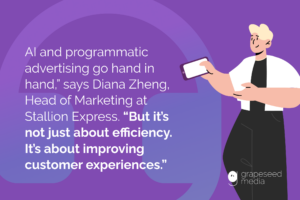
The advancement in AI capabilities will continue to improve personalization, content creation, and predictive analytics. AI algorithms are now adept at crafting compelling content, whether it’s writing ad copy or generating visual ad elements. Predictive analytics — powered by AI — are becoming more accurate, allowing marketers to anticipate customer needs and trends effectively.
Other trends in AI and automation in 2024 include real-time bidding optimizations in ad exchanges, AI-driven customer segmentation, and the use of AI in optimizing ad placements and formats.
However, as AI and automation grow more integral to digital advertising, the importance of data privacy escalates — advertisers must ensure that sensitive data is securely handled and that trust is maintained with users.
This involves complying with data protection regulations, being transparent about data usage, and employing robust cybersecurity measures to safeguard consumer information. This balanced approach will be crucial in maintaining consumer trust while harnessing the full potential of AI in digital marketing.
5. Cookie Alternatives Will Become More Precise
The cookieless future is finally here. In 2024, with major browsers like Apple and Firefox having already ended third-party cookie support and Google’s ending soon, one-third of potential audiences use browsers or devices where third-party cookies don’t work.
advertisers are exploring various alternatives. These include:
- First-party data: Leveraging data collected directly from users.
- Universal IDs: Creating more accurate user identifiers across devices and platforms.
- Contextual targeting: Focusing on the context of web pages to serve relevant ads.
- Clean Rooms: Environments where data from various sources can be analyzed without compromising privacy.
- Federated Learning of Cohorts (FLoCs): Grouping users based on browsing habits.
- Customer data platforms: Unifying customer data from multiple sources for deeper insights.
- Google’s Privacy Sandbox: A set of technologies by Google to enhance privacy while still allowing targeted advertising.
These alternatives aim to respect user privacy while still enabling effective advertising strategies. Advertisers are encouraged to clearly communicate their data privacy practices to maintain consumer trust.
For more detailed insights on these alternatives, refer to this article on cookieless identity solutions.
6. In-App and In-Game Ads Will Grow in Popularity
In 2024, in-app and in-game advertising will see significant growth. Nearly 95% of free-to-play mobile games are supported by in-app advertising, which is highly successful due to its ability to engage users with reward-based ad delivery systems.
According to Sudir Khatwani, Founder of The Money Mongers, “In-app and in-game advertising is becoming more interactive and immersive. Simple banners are being replaced by mini-games and engaging videos that blend seamlessly into the user experience. Rather than merely eye-catching, ads are now fun diversions that users actively enjoy.”
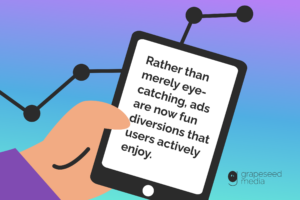
Big players like Sony and Microsoft are showing interest in this sector, recognizing the vast demographic reach of gaming across all ages, genders, and income brackets.
This growth is supported by innovations in technology (including — you guessed it — AI) and changing advertising strategies, making in-app and in-game advertising a key trend to watch in 2024’s digital advertising landscape.
However, a lot of accidental clicks occur with in-app and in-game ads, so any placements on these platforms must be closely monitored, and any under-performing apps should be blacklisted.
7. Programmatic Digital Out-Of-Home Will Reach New Heights
In 2024, programmatic digital-out-of-home (pDOOH) advertising will continue to grow, with ad spend projected to increase by 57% between 2023 and 2028, reaching $15.53 billion, reflecting the effectiveness and innovation within the sector.
Furthermore, the majority of marketers recognize pDOOH for its brand safety, with two out of three endorsing its ability to ensure a secure environment for brand messaging.
Brands that can create memorable, attention-grabbing creatives for this medium will be able to capitalize on audience appetites for more personalized, interactive, and immersive ads.
In 2023, notable pDOOH campaigns showcased the versatility and potential of this medium, combining creativity with technological advancements to engage audiences in dynamic ways, such as:
-
- OVO, a UK-based energy provider, achieved an industry first by tapping into data from the National Grid ESO and using programmatic bidding to only bid and display campaign creatives at times when the grid was greener.
- On, a Swiss sportswear company that used footfall data to measure the effectiveness of its pDOOH campaigns.
- Uber Eats, which combined location data with dynamic creative optimization (DCO) to serve ads displaying dishes from nearby restaurants.
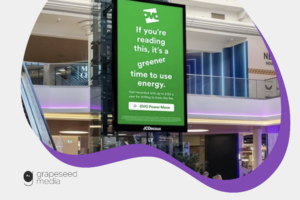
For more insights into pDOOH, check out this blog post on the types of pDOOH screens, or learn about partnering with Grapeseed Media for your pDOOH campaigns.
2024 Programmatic Advertising Trends: A New Era of Creativity and Growth
As 2024 develops, digital advertising is set to undergo exciting changes. With AI continuing to drive innovation and the emergence of new, privacy-conscious advertising strategies, the potential for growth and creativity in the field is immense.
From the rise in political ad spend to VR/AR ads, advertisers will engage audiences in novel and impactful ways.
So buckle up, because 2024 promises to be a thrilling journey of innovation and engagement.
If you’re looking for an expert partner to help you navigate these trends, book a call with the Grapeseed Media team to discuss how we can help you.

